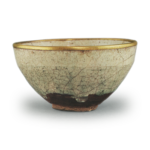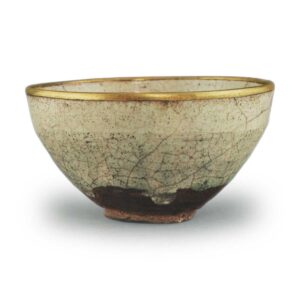
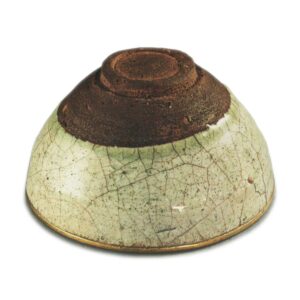
White Tenmoku Chawan
Great Masterpieces
Important Cultural Property
Collection: Tokugawa Art Museum
Height: 6.6-6.8cm
Bowl diameter: 12.2-12.3cm
Outer diameter of base: 4.5 cm
Height: 0.7cm
A tea bowl in the tenmoku style with a thick feldspar glaze similar to that of Shino is commonly called shiro-tenmoku. There have been several pieces excavated from kiln sites in Mino in recent years that are thought to date back to the Momoyama and early Edo periods, but the only two known examples of this type of ancient white tenmoku are this tea bowl, which belonged to the Tokugawa family of Bishu, and the Jitenmoku, which was formerly owned by the Maeda family of Kaga. Both are great masterpieces and are designated as Important Cultural Properties.
Shiratenmoku is the oldest white pottery in Japan, and both are said to have belonged to Takeno Shaowo. Since Shao’o died on October 29, 1555 at the age of fifty-four, these tea bowls should be considered to have been made before that.
It is still unclear today whether this type of Hakutenmoku was made in Seto or Mino. Remnants of Hakutenmoku have been found at the Asahi Kiln in Seto, and in Mino, pieces have been found at the remains of many kilns, including those at Oyaya, Ohira, Takane, and Kusjiri, but it is not yet known where the oldest kiln of this type of Hakutenmoku was located. The clay seems to be Mino clay, and there is a theory that it may have come from Jorinji, but this is a matter for future research and discovery.
The clay is a lumpy white clay with a thick transparent feldspar glaze on the interior and exterior, and the lower part of the body is exposed.
The glaze is well baked and flows down, and the area where the glaze has accumulated at the waist has a slight olive color. The inside of the vessel has a slightly high prospect, and the slightly sunken area around it is thickly covered with underglaze glaze, giving it the same slightly olive color. There are rough penetrations on both the interior and exterior surfaces, and tea stains have seeped into these and turned them blackish brown.
The shape of the lid is the so-called “tenmoku” style, which is open at the mouth and narrow at the waist, and has a tight base, but it does not have the harshness of Chinese kenkobutsu. In particular, the mouth is not as tight as that of the tatebana, and the shallowly carved base is thick and soft, without the sharpness of the tatebana. The warm and soft feeling is a characteristic of Japanese ceramics as a whole, not limited to Shiro-tenmoku.
The rim is covered with a thick layer of pure gold, which harmonizes beautifully with the thick white glaze.
The firing temperature was about 1,250 degrees Celsius, and the glaze was well melted, revealing the bare skin, and it flowed down and collected on the hips and the front of the bowl. The glaze is slightly olive in color, and at first glance it looks like a pale yellow Seto, but it is more appropriate to think of it as a well-fired Shino ware.
Three bags, white crepe, brown-ground stone karamono-SAKI, Shaoio Danshi
Inner box, black lacquered, pasted decoration, inscription “Shiro Tenmoku Takeno
Outer box, Shunkei lacquer, gold-painted, gold-powder lettering, “White Tenmoku, Takeno Shaowo’s possession.
The item was originally owned by Takeno Shao’o, but his descendant, Takeno Shin’emon, donated it to the Tokugawa family in Bishu, according to the ledger of the collection of the Tokugawa family in Bishu.
Mino White Tenmoku Tea Bowl
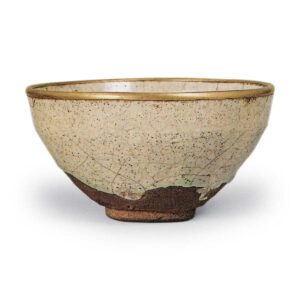
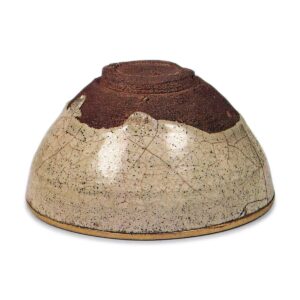
Great Masterpieces
16th century
Height 6.5cm, mouth diameter 12.1cm, bottom diameter 4.4cm
Important Cultural Property
Tokugawa Meikai
This is a well-known white tenmoku tea bowl that belonged to the great tea master of the late Muromachi period, Takeno Shao’o, along with the white tenmoku tea bowl that was handed down from the Maeda family. According to the history of the Tokugawa family, “This item belonged to Takeno Shao’o. Shin’emon, the youngest grandson of Shaoyo, gave it to this family and passed it down from generation to generation. According to the Nagoya City History, Shin’emon was named Takeno Nakasada, a grandson of Shaoyo and son-in-law of Sokara. He served under Oda Ariraku, and was later summoned by Yoshinaga Yoshimasa, the founder of the feudal domain, to become a yoroi, receiving a grant of 400 koku.
This white tenmoku tea bowl is thought to have been made between the end of the 15th century and the beginning of the 16th century, judging from the lack of a distinct neck under the mouth rim, the rounded waist, the high standing form, and the shape of the carved base. The yellowish-brown, slightly coarse, and somewhat rough base, along with the glaze, indicates that this is a possible Mino product. Some have suggested that the white glaze is ash-covered by naked firing because of the extremely thin layer on the interior surface and the light green ash accumulation on the lower rim of the exterior surface, but the fact that the ash glaze is evenly distributed over the entire surface and that there are no deposits at all on the surface suggests that this was fired in a saggars, It is considered to be a Shino glaze, which is mainly made of feldspar and to which is added Shino. In recent years, shards of ash-Shino glaze have been found somewhat similar to those from the Onada Ogane Kiln or the Ohirazan no Kami Kiln, strengthening the possibility that this ware was discovered in Mino.

